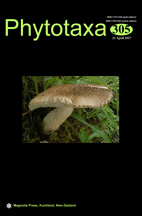Abstract
Among 240 specimens of Trichoderma producing sexual states collected in different regions of China, 80 specimens representing 21 species possess green ascospores. Species were identified based on integrated studies of phenotypic features, culture characteristics and molecular analyses of RNA polymerase II subunit b and translation elongation factor 1-α genes. Of these 21 species, seven are recognized here as new: T. angustum, T. crystalligenum, T. globoides, T. perviride, T. purpureum, T. tenue and T. viridulum. Trichoderma angustum and T. crystalligenum belong to the Strictipile clade, and the remaining five species are in the Harzianum clade. Trichoderma angustum inhabits herbaceous stems and possesses trichoderma- to verticillium-like conidiophores. Trichoderma crystalligenum forms brownish yellow pulvinate stromata, pachybasium-like conidiophores, and abundant yellow crystals in culture. Trichoderma globoides and T. perviride share a common ancestor with but are different from T. alni, T. christiani, T. corneum and T. italicum. Trichoderma purpureum is a sister of T. epimyces, and is distinguished by its purplish red stromata. Trichoderma tenue is closely related to T. priciliae and T. rufobrunneum, and is characterized by verticillium-like conidiophores and slender phialides. Trichoderma viridulum is associated with T. cerinum, T. tomentosum and T. ceraceum; it is distinguishable by trichoderma-like rather than pachybasium-like conidiophores. Morphological distinctions between the new species and their allies are discussed. This study updates our knowledge of species diversity of the group.

